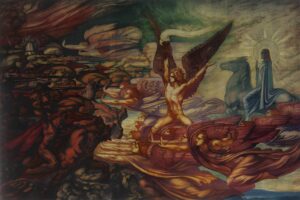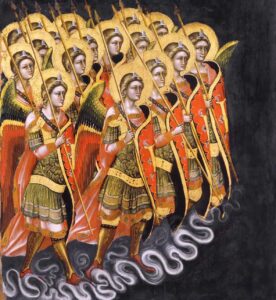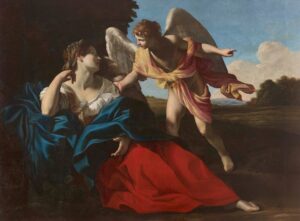Key Takeaways
- Ancient Guardians: Cherubim originated as powerful guardian figures in Mesopotamian and Assyrian cultures, blending human and animal traits to symbolize divine protection.
- Biblical Transformation: In the Hebrew Bible, cherubim became theological symbols guarding Eden and carrying God’s throne, embodying divine justice and presence.
- Rabbinic Interpretation: In Jewish mysticism, cherubim symbolized God’s wisdom, justice, and mercy, and acted as intermediaries between heaven and earth.
- Christian Reinterpretation: Early Christian thought connected cherubim to virtues and associated them with the four evangelists, symbolizing divine knowledge and protection.
- Renaissance Softening: The Renaissance transformed cherubim into putti or cupids—childlike symbols of love and innocence influenced by Greco-Roman art.
- Modern Popularity: Today, cherubim are widely recognized as symbols of love and nostalgia, appearing frequently in art, literature, and commercial settings.
- Psychological Symbolism: In psychology, cherubim are seen as archetypes of inner protection and balance, representing self-acceptance and spiritual resilience.
Cherubim stand among the most intriguing figures in Judeo-Christian imagery, recognized today as gentle, often playful beings associated with love, innocence, and spiritual grace. Yet their origins are far more complex and formidable. Tracing the evolution of cherubim reveals a long, dynamic journey through ancient religions, biblical traditions, theological interpretations, artistic reinventions, and cultural adaptations. These beings once embodied the power and mystery of divine realms, guarding sacred spaces and symbolizing the boundary between humanity and the divine. Over time, cherubim transformed into the charming, childlike cupids of Renaissance art and popular culture.
This article examines how cherubim emerged from ancient Near Eastern guardians, took on new roles in the Hebrew Bible, were interpreted by early Judaism and Christianity, and were reshaped by the Renaissance into familiar, endearing figures. By exploring their portrayal across different epochs—ancient temples, biblical texts, mystical commentaries, Christian theology, Renaissance painting, and modern imagery—we gain insight into the enduring significance of cherubim. Their evolving forms reflect shifting spiritual values, cultural encounters, and human efforts to understand the divine and its relationship to the human world.
Cherubim have long captivated believers and scholars. These celestial beings evolved dramatically, from formidable guardians of divine realms to the familiar, playful cherubic figures associated with innocence and romance. This evolution, shaped by shifting cultural, religious, and artistic contexts, has transformed cherubim into some of the most multifaceted symbols in Judeo-Christian iconography.
Across millennia, cherubim carried profound meanings that adapted with each era. In the Hebrew Bible, cherubim guard sacred spaces, embodying divine presence. In Ezekiel’s prophetic visions, they appear as surreal, multi-faced beings representing cosmic power and divine order. Christianity brought new interpretations, merging cherubim with Greco-Roman ideals, and the Renaissance softened their image further, turning them into putti or cupids—symbols of love, innocence, and beauty.
Table of Contents
Origins and Ancient Near Eastern Influences
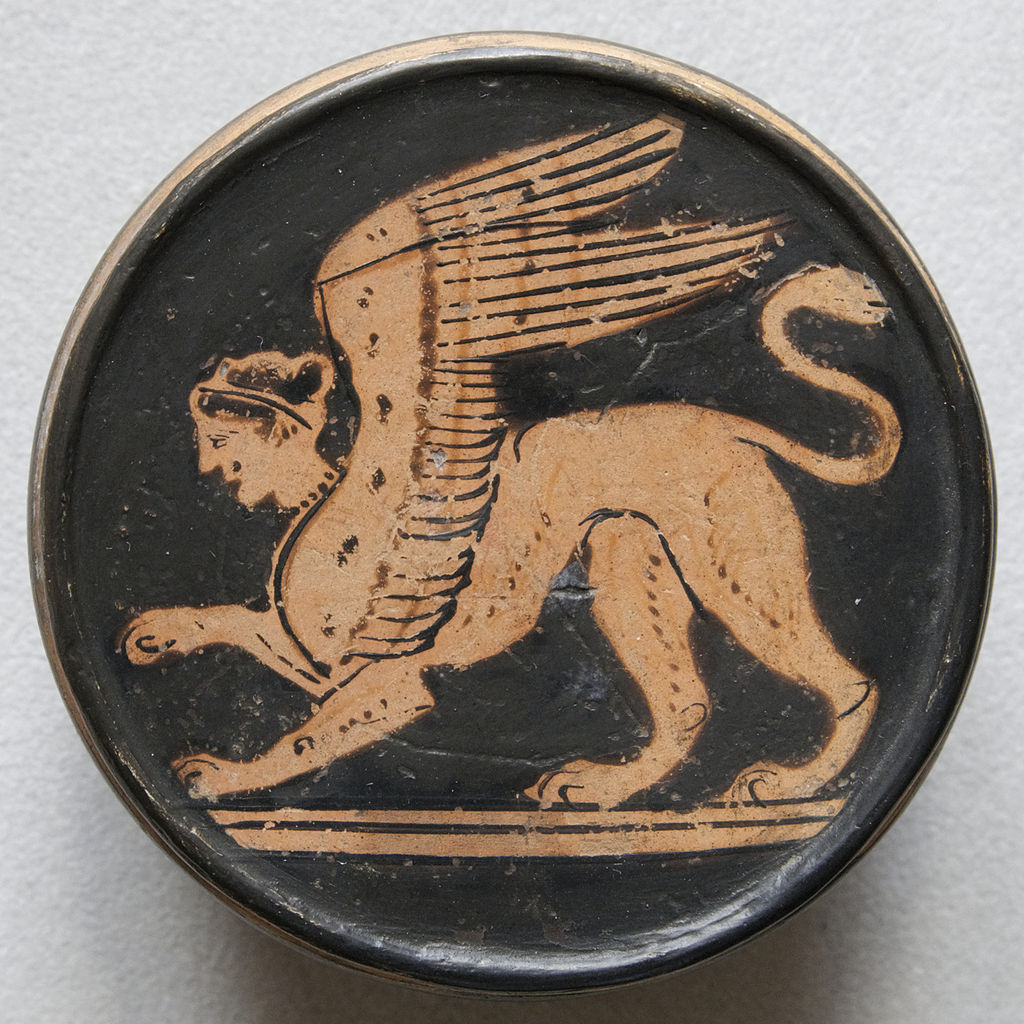
Mesopotamian and Assyrian Influences
The earliest roots of cherubim stretch deep into the ancient Near East, where hybrid guardian creatures adorned temples, palace gates, and royal courts. In Mesopotamia and Assyria, beings like the lamassu or shedu combined human faces with the bodies of lions or bulls and the wings of eagles. Standing as colossal sculptures at palace entrances, they represented ultimate authority and protection, warding off evil and affirming the ruler’s cosmic legitimacy. Scholars believe that the Hebrew term “cherub” may share linguistic or conceptual ties with these Assyrian words related to protective spirits, linking the origins of cherubim to a broader cultural milieu where power and sacredness intertwined.
The Sphinx and Levantine Art
Comparable guardian figures appeared in Egypt, notably the sphinx—a lion-bodied, human-headed figure embodying sovereignty, divine might, and religious sanctity. Along the Levantine coast, Canaanite ivory carvings and other art forms depicted winged creatures that blended human and animal traits. These designs influenced the cultural tapestry of the Israelites, who adapted and transformed these earlier guardian archetypes into cherubim. Initially resembling the Near Eastern hybrids, these beings gradually acquired distinct theological significance, serving not just as protectors but as direct agents of the one God—Yahweh.

Cherubim in the Hebrew Bible: Guardians and Divine Attendants
Guardians at Eden’s Threshold
Cherubim first appear in the Hebrew Bible at the gateway of Eden (Genesis 3:24), where they wield a flaming sword to prevent humanity from reentering paradise. This depiction highlights their role as fearsome intermediaries, separating the mortal realm from the divine. Unlike their Near Eastern forebears who symbolized dynastic power or physical protection, these cherubim embody spiritual and moral boundaries. They ensure that humankind, now burdened by sin, cannot regain immediate access to the Tree of Life.
The Ark of the Covenant and the Mercy Seat
Cherubim play a central role in the construction of the Ark of the Covenant (Exodus 25:18–22). Two cherubim made of gold sit atop the Ark’s cover, known as the “mercy seat,” their wings arching inward to form a canopy. Here, cherubim serve as divine throne-bearers, framing the space where God’s presence was believed to dwell and communicate with Israel’s leaders. This innovation merges the protective function of cherubim with a profound theological statement: God’s immanence rests above these angelic figures, forging a link between heaven and earth, transcendence and intimacy.
Temple Imagery and Cosmic Symbolism
In Solomon’s Temple (1 Kings 6:23–29), massive cherubim carved from olive wood and overlaid with gold towered in the Holy of Holies. Their colossal presence emphasized the sanctity of the space and symbolized divine kingship. Meanwhile, the prophet Ezekiel’s visions (Ezekiel 1; 10) present cherubim as dynamic, multi-faced creatures—human, lion, ox, and eagle—encompassing the breadth of creation. Covered in eyes, they move with divine chariots, reflecting cosmic scope and omniscience. These biblical portrayals underscore cherubim’s evolving complexity: they are simultaneously guardians, throne-bearers, and cosmic agents conveying divine order.ly as guardians but as carriers of divine sovereignty across creation, a departure from their earlier protective roles.
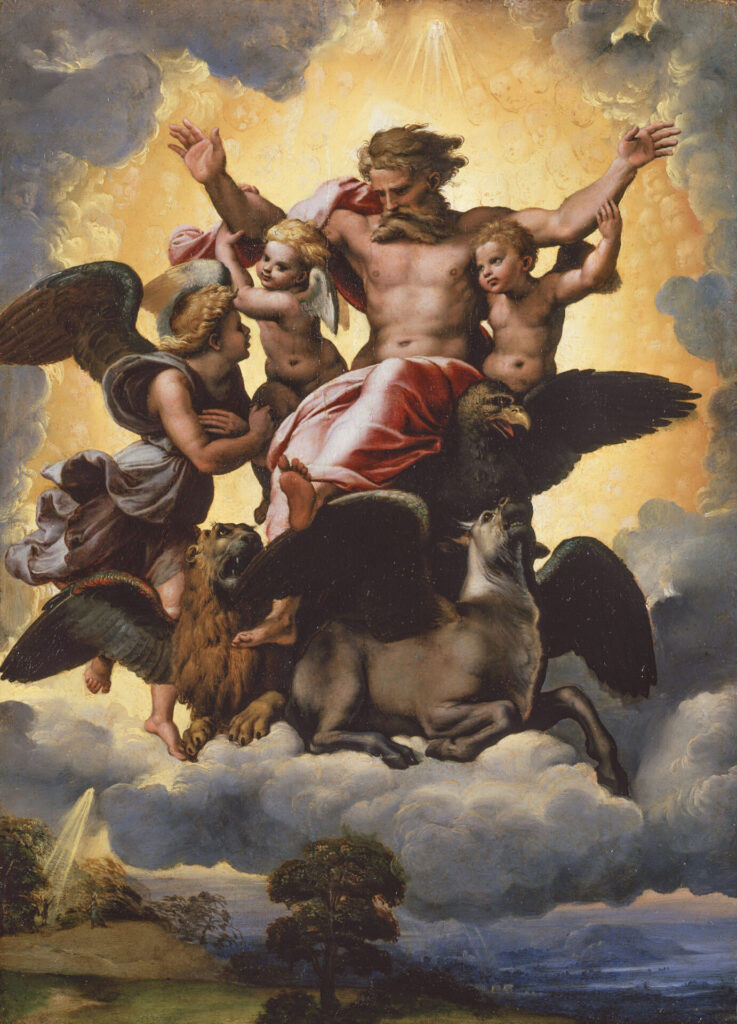
Rabbinic and Early Christian Interpretations: Layers of Meaning
Rabbinic Literature and Mystical Dimensions
As Judaism developed beyond the biblical period, cherubim acquired allegorical and mystical interpretations. Rabbinic sages considered the cherubim atop the Ark as symbols of divine love and covenantal fidelity. Some texts imagine that when Israel followed God’s commands, the cherubim faced each other in harmony, and when Israel strayed, they turned apart. In mystical Jewish writings like the Zohar, cherubim are woven into angelic hierarchies and cosmic architecture, representing aspects of divine wisdom, justice, and mercy. No longer mere physical guardians, they become spiritual metaphors for God’s relationship with humanity.
Early Christianity: Evangelists, Virtues, and Divine Knowledge
Christian thought, building upon Jewish foundations, integrated cherubim into its angelology and symbolism. Early Christian writers, influenced by Ezekiel’s vision, associated the cherubim’s four faces with the four evangelists: Matthew (human), Mark (lion), Luke (ox), and John (eagle). This interpretation aligned cherubim with the spreading of the Gospel, casting them as heralds of divine truth. In the works of Pseudo-Dionysius the Areopagite, cherubim ranked among the highest angelic orders, embodying heavenly knowledge and insight into God’s mysteries. Church Fathers emphasized their role as symbols of divine wisdom and spiritual understanding, blending Hebrew traditions with Greek philosophical concepts.
Byzantine and Medieval Imagery
In Byzantine iconography and medieval Christian art, cherubim often appeared as majestic, winged beings—sometimes with multiple faces—floating in ethereal space around Christ or the Virgin Mary. Liturgical texts and hymns referenced them as ceaseless praisers of God, evoking a heavenly chorus that surrounds the divine throne. In medieval theology, cherubim, along with seraphim and thrones, formed the highest triad of angels closest to God. This triadic structure highlighted their intimacy with divine reality, linking them to contemplation, illumination, and the eternal hymns of praise that resound in the celestial courts.
The Renaissance Reimagining: From Guardians to Cupids
Classical Influence and the Emergence of the Putto
The Renaissance era catalyzed a dramatic transformation in cherubic imagery. Europe’s rediscovery of classical antiquity introduced artists and patrons to the world of Eros (Cupid) and winged infant figures that symbolized love and beauty. Renaissance masters like Raphael reinterpreted cherubim by merging their angelic identity with the classical putto—a small, chubby, winged child. This shift softened cherubim’s once-fearsome persona, humanizing them into approachable, endearing beings.
Symbols of Love, Innocence, and Human Emotion
Now free from their earlier roles as cosmic guardians, cherubim depicted as putti expressed a broad spectrum of meaning. In religious art, they accentuated divine grace, hovering around the Madonna and Child or attending scenes of the Nativity. Their innocent smiles and tender glances suggested purity and spiritual comfort. In secular and mythological themes, putti reinforced notions of romantic and earthly love, frolicking in allegorical scenes or supporting heraldic emblems. Artists like Donatello and Botticelli spread these cherubic figures across frescoes, sculptures, and decorative motifs, embedding them in European artistic consciousness.
Cultural Adaptation and Enduring Appeal
The childlike cherubim-turned-putti appealed to a broad audience, transcending linguistic and cultural boundaries. They adorned the ceilings of chapels and palaces, enlivened marriage chests, and found their way into tapestries and illuminated manuscripts. This popularity reflected broader Renaissance humanism, which celebrated the harmony between divine ideals and human emotions. Instead of representing moral or existential boundaries, cherubim now symbolized accessibility, linking heavenly affection with human warmth. Their enduring appeal helped cement them in Western visual culture, influencing how future generations would perceive angelic beings.
Beyond the Renaissance: Modern Interpretations and Cultural Resonance
Popular Culture and the Cupid Motif
In contemporary culture, cherubim, often conflated with cupids, continue to appear in diverse contexts. From Valentine’s Day cards adorned with cherubic characters to wedding decorations and baby-themed imagery, the cherub-cupid motif signifies love, affection, and innocence. Their rounded cheeks and tiny wings have become visual shorthand for warmth, making them familiar icons in greeting cards, advertisements, decorative objects, and even digital emojis. Over time, the cherubic figure has adapted to the language of modern design, marketing, and personal expression, proof that ancient symbols can evolve endlessly to suit new narrative and commercial needs.
Revisiting Ancient Archetypes in Modern Spirituality
Despite the prevalent childlike image, some modern spiritual movements and esoteric traditions revisit the ancient, more complex portrayals of cherubim. Contemporary artists and mystics draw on Ezekiel’s descriptions to produce visionary art featuring four-faced beings, radiant wheels, and fiery wings. In certain New Age or esoteric circles, cherubim are interpreted as multidimensional guardians who watch over cosmic cycles or guide spiritual seekers toward higher truths. This revival of older imagery highlights the cherubim’s versatility: they can be both playful reminders of love and formidable symbols of divine complexity, depending on one’s perspective and purpose.
Literature, Music, and Popular Media
Cherubim have also inspired a range of literary and musical expressions. Poets and authors might invoke cherubim to evoke purity, trust, or the transcendent. John Milton’s Paradise Lost mentions cherubim as part of heaven’s hierarchical hosts, blending biblical and classical references to convey the grandeur and moral stakes of cosmic conflict. Composers have included cherubic choirs in oratorios, masses, and hymns, treating them as aural representations of heavenly praise and spiritual elevation. In modern fantasy and science fiction, cherubim-inspired creatures sometimes appear as powerful guardians or enigmatic intermediaries between worlds, paying homage to the ancient archetype while granting it new narrative roles.
Psychological and Symbolic Interpretation
Some psychologists and scholars of myth analyze cherubim through a symbolic lens. Their transformation from imposing guardians to gentle companions can mirror aspects of the human psyche. The earlier cherubim represent the mind’s strong defenses and the necessity of boundaries between the known and unknown, the holy and the profane. The Renaissance cherubim, on the other hand, reflect humanity’s longing for intimacy, comfort, and relational depth. As archetypes, cherubim can represent the interplay between vulnerability and strength, innocence and wisdom, thus offering rich material for depth psychology and symbolic interpretation.
Religious Continuity and Adaptation
In Judaism, cherubim remain part of cultural and religious imagination, recalling the Ark of the Covenant and symbolizing God’s presence and covenantal relationship. Some synagogues’ Torah arks feature cherubic motifs, linking the community’s worship to ancient temple imagery. In Christianity, cherubim appear in church architecture, stained glass windows, and liturgical vestments, signifying closeness to the sacred. Orthodox icons and Catholic art sometimes show cherubim as red-winged angels symbolizing knowledge, or as ranks of angels encircling saints, martyrs, and the Virgin Mary. Their persistent presence in religious symbolism underlines how they remain integral to conveying spiritual truths, whether as protectors, witnesses, or joyful participants in divine worship.

Cherubim Across Cultures and Religious Boundaries
Although cherubim are primarily associated with Judeo-Christian traditions, their conceptual echoes may be found in other religious and mythological systems that feature winged guardians or intermediaries. In Zoroastrianism, Yazatas guard and maintain cosmic order; in Hindu art, apsaras and gandharvas sometimes serve roles linking heavenly realms with human devotion. While these figures differ significantly, the universal human impulse to imagine winged creatures as messengers, protectors, or symbols of transcendence resonates across multiple faiths and mythologies. The cherubim’s evolution is one strand in a tapestry of global religious iconography exploring how humans connect with the divine.
Modern interfaith dialogues and comparative religious studies sometimes use cherubim as a reference point, illustrating how symbols transform when carried into different theological contexts. By examining cherubim alongside other guardian figures, scholars can better understand how certain religious ideas endure and adapt, reflecting both continuity and innovation. Such studies underscore that cherubim, while rooted in Hebrew scripture and Christian tradition, tap into universal themes of protection, boundaries, love, and divine presence that transcend cultural lines.
Cherubim in Contemporary Artistic Expression
Fine Arts and Installations
Contemporary artists occasionally revisit cherubic imagery to comment on spirituality, identity, and cultural memory. Painters and sculptors may depict cherubim in unexpected forms—fragmented, abstracted, or combined with modern symbols—to spark reflection on faith, nostalgia, or the commodification of religious images. Cherubim appear in street art, gallery installations, and avant-garde performances, challenging viewers to reconsider familiar motifs. These reinterpretations prove that cherubim remain fertile ground for creative exploration and intellectual debate, bridging past and present meanings.
Digital Media and Gaming
In digital media, cherub-like characters occasionally populate video games, anime, and virtual landscapes. They might serve as helpful guides in fantasy adventures, offer healing or protective powers, or symbolize the purity of a realm threatened by chaos. In these contexts, cherubim contribute to immersive storytelling, signifying trust, guidance, or hope. Their evolution into digital avatars of virtue and affection demonstrates how ancient symbols can maintain relevance in technological societies, blending ancient archetypes with contemporary entertainment.
Conclusion
The evolution of cherubim—from powerful, sphinx-like guardians in ancient Mesopotamia and Canaan to gentle, childlike figures signifying love and innocence—testifies to the adaptability and resilience of religious symbols. Initially, cherubim stood as formidable sentinels of sacred spaces and intermediaries separating humanity from divine perfection. In the Hebrew Bible, they became integral to Israelite theology, embodying God’s presence, cosmic order, and the delicate boundary between holiness and human experience.
Over time, cherubim acquired new dimensions through rabbinic mysticism, Christian theology, and iconography. Early Christians associated them with the evangelists and higher angelic orders, transforming them into symbols of divine wisdom and gospel truths. The Renaissance era introduced a dramatic shift, merging cherubim with classical putti and repositioning them as emblems of love, purity, and emotional warmth. This recasting aligned with humanistic ideals that embraced beauty, compassion, and the bridging of celestial and earthly realms.
In modern culture, cherubim (often conflated with cupids) have found a stable niche in popular imagination. They appear in greeting cards, advertisements, home décor, and digital media, signifying affection, hope, and tenderness. Concurrently, some spiritual communities and artists return to ancient, more complex images of cherubim, celebrating their original mystery and power. Across literature, music, visual arts, and psychology, cherubim serve as versatile symbols reflecting human quests for meaning, security, and transcendence.
Ultimately, the cherubim’s extraordinary journey underscores how religious and mythic symbols are not static relics. Instead, they live and breathe through cultural shifts, theological reinterpretations, and artistic innovations. Cherubim remind us that our understanding of the divine evolves over time. Once fearsome guardians barring the way to Eden, they now often beckon us toward trust, love, and deeper connection. In their many forms—ancient guardians, biblical throne-bearers, mystical allegories, Renaissance cupids, and modern cultural icons—cherubim embody humanity’s changing relationship with the sacred, inviting us to contemplate the rich interplay between tradition and transformation.

